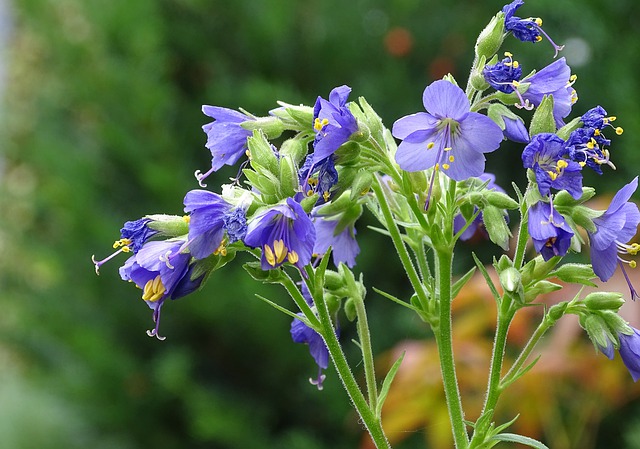 |  |  |  |  |
 |  |
Jacob’s-ladder
is a perennial herb up to 120 cm high (cultivated up to 150 cm). The plant has a short (3-5 cm long), unbranched rhizome. The rhizome grows horizontally and has many small, light roots. Stem single or paired, erect, hollow, hairy, simple or branched at the top. The leaves are arranged alternately, the lower ones on petioles, the upper ones are sessile. The flowers are sky blue, violet blue, rarely blue and white, arranged at the top of the stem, in a panicle.
Fruit a three-parted knob, many testes. Seeds small, dark black or black, flattened and elongated, up to 3 mm long.
In the first year of life, the plant forms rosettes of root leaves, it begins to bloom and produce seeds only in the second year of life. Flowers in June and July, seeds ripen in August and September.
Rhizomes with roots are collected for medicinal purposes. The underground part is harvested at the end of the plant's vegetation, when the plant has finished producing seeds. The roots are rinsed in running and cold water and the remains of the surface plant are separated. The rhizomes are cut lengthwise and dried on sieves or in forced dryers, not exceeding 50-60C. The drug is piled on sieves in a thickness of 8-10 cm, stirring the drug from time to time. As a result, you will get 20% dry mass from freshly harvested. The finished drug is slightly curved rhizome parts 0.5-5 cm long and 0.3-2 cm thick. The surface of the rhizome is rough, gray-brown, yellowish-white at the cut. The smell is weak, peculiar, the taste is bitter. Drug storage time up to 2 years.
All parts of the
Jacob’s-ladder
contain triterpene glycosides - saponins. Saponins are especially abundant in the root of the first and second year plant (up to 30%). In addition, the plant also contains alkali (1.28%), organic acids, vegetable fats and essential oils, and the plant also accumulates minerals (zinc, cadmium, aluminum, barium, a lot of iron and silver).
Medicinal properties
The strong effect of the
Jacob’s-ladder
is based on the high presence of saponins in the rhizomes. Thanks to the irritating effect of saponins on the respiratory mucosa, the plant increases secretion and helps to get rid of sputum. Saponins have a sedative and calming effect on the central nervous system, reduce reflex excitation. In addition, the
Jacob’s-ladder
has hypotensive, antisclerotic, wound-healing and other healing properties.
In folk medicine, the
Jacob’s-ladder
is used as a sedative in case of insomnia and nervous excitement. It reduces reflex nervous excitement, nervous tics, convulsions and hyperactivity. A decoction of the rhizome of the
Jacob’s-ladder
is used in epilepsy, depression, headache, panic and hysteria. The
Jacob’s-ladder
shows its most valuable properties when it is used to treat cough, bronchial spasms and bronchopneumonia, catarrhal and obstructive respiratory conditions, as well as lung abscess.
In folk medicine, the
Jacob’s-ladder
is used mainly as an expectorant. For example, in the case of pulmonary tuberculosis, preparations of the
Jacob’s-ladder
help expectoration, stop internal bleeding, and also liquefy sputum.
In folk medicine, the
Jacob’s-ladder
is used together with the marsh hare's foot as a healing agent, for the treatment of stomach ulcers and duodenum. It is used in mixtures to treat psoriasis. In addition, the
Jacob’s-ladder
prevents the deposition of fat on blood vessels.
